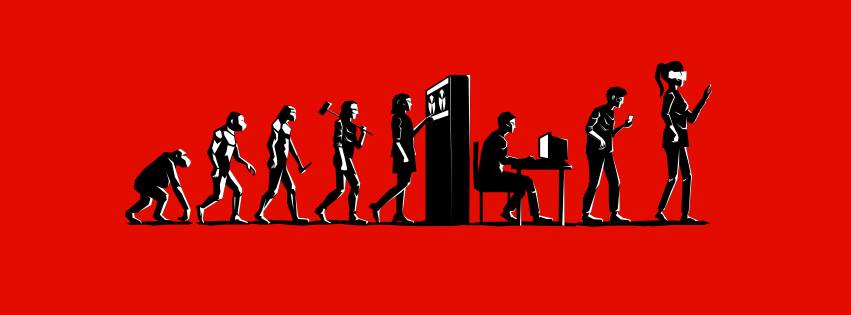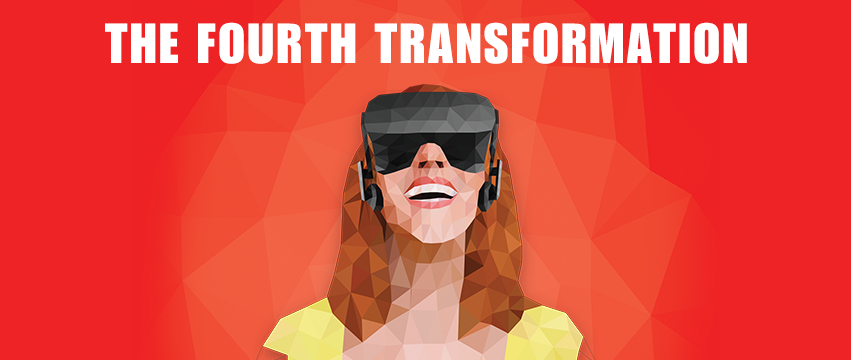I started to really appreciate futurists Robert Scoble and Shel Israel through their 2013 book Age of Context: Mobile, Sensors, Data and the Future of Privacy . It focused on emerging interactive technologies, and shared some companies to watch. Wearable computing, one of the key focus areas of that book, plays a huge part in their new one.
IN THE BEGINNING, there were mainframes
The book’s introduction starts with an overview of three transformations that followed the mainframes:
- From mainframes to interacting with desktop computers using a keyboard
- The graphical user interface (GUI), and specifically the mouse
- Touch interfaces, including mobile devices
The Fourth Transformation? That would be “Spatial Computing.”
The Fourth Transformation didn’t initially seem especially interested in discussing the actual technology. The focus was more on how retailers and marketers had better get with the program of augmented reality /virtual reality / mixed reality technologies. “If you are part of a big brand, you need to know about this now so you can understand how your customer relationships are about to change and so you begin to adjust course.”
As the book progressed, it focused more on the AR/VR/MR technology and how it is applied. That’s great by me. I like tech, but I’m especially interested in applied technology.

Walking Upright
The book makes repeated references to technology that will allow phone users to once again “walk upright”. Rather than sitting and walking hunched-over, lightweight (and even stylish!) headsets will allow us to interact with the environment more naturally and intuitively.
Scoble famously embraced Google Glass, wearing the geeky computerized glasses frequently. He spoke of being “all-in” relative to social media and communications tech. I am reminded of when I met Scoble and asked him if there were limits to his “all-in” philosophy. He responded that he wasn’t prepared to wear Google Glass in the bedroom, and wasn’t about to let his Apple ID out into the wild. Other than that, he was prepared to give the technology access to pretty much all the information it could consume.
Though I’m not so quick to “share all,” I do look forward to devices that learn from us and don’t require that we look down at a screen all the time.
Minecrafters
Today’s school kids are referred-to here as Minecrafters, after the popular game many play. “As Minecrafters, they have not known a world without smartphones and tablets. When they want to try a new game, they don’t turn to their parents for guidance or permission, they go to YouTube, learn about a game, choose and download it. This is a culture change in that kids learn to do things for themselves in more ways, more often.”
These tech natives don’t remember a time when there weren’t computers. From their perspective, the Internet and cell phones have always existed. This generation expects technology to get better and better, and doesn’t have a strong sense of privacy. The idea of putting-on high-tech specs that see what they see and know what they like is not scary. Quite the contrary, it’s exciting.
Where We Are Today
Pokémon GO and Snapchat filters are somewhat primitive, but increasingly familiar, examples of augmented reality. Consultant Brian Fanzo, and marketer Gary Vaynerchuk (who wrote the book’s Foreword) share observations on marketing. Vaynerchuk has said that “Snapchat is the best marketing tool you can use right now.” That’s a shock, remembering that Snapchat was originally best known for facilitating teenage sexting.
How important is it for companies to become familiar with these technologies? Scoble and Israel raved about the work being done by a startup called Eyefluence. I tried to check-out their web site, but it was broken. It still is. It turns out that’s because the company was in flux. On the last day that this book was being finalized, “Eyefluence became part of something bigger in another sort of way. Google announced on Oct. 30, 2016, that it would acquire the company.” Just that fast, Eyefluence went from company-to-watch to a Google acquisition.
Raj Singh, managing director at JetBlue Technology Ventures, recently cautioned:
My advice is, don’t fall in love with the technology. Find a business case. I see a ton of technology. I was at a VR/AR event yesterday, and all these guys had these wonderful predictions about how this is going to change our life, but not one of them could come up with a solid business case for a killer application that would allow them to get out there, flourish and make money… If you’re going to be a business, find a customer.
"My advice is, don’t fall in love with the technology. Find a business case."
– @trajsingh to tech startups. @starburstinnov— Steve Case (@JoeBugBuster) December 1, 2016
This new book lays out several business cases. The trick will be for companies to use the tech as well-considered tools – not just cool stuff.


Outstanding. As I read this on my iPhone 6s Plus. Ironic It’s become a tool with me, always present with the Android smartphone in the other pocket. You’re a smart man, Steve, and insightful.
Thanks for the kind words Scott.